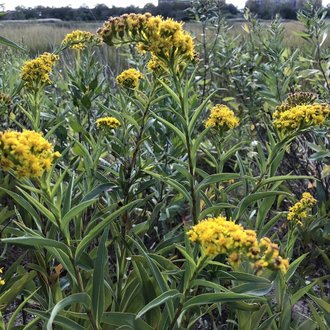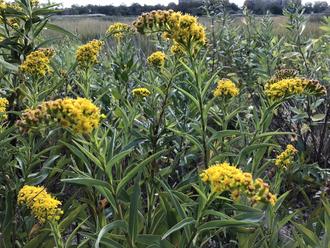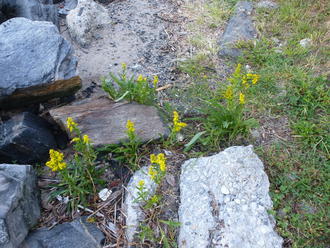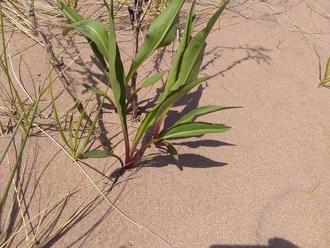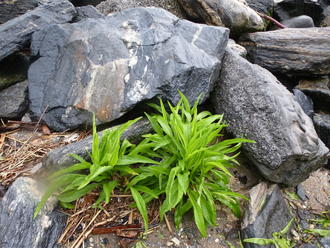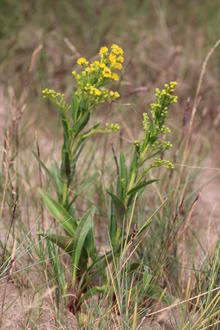Seaside Goldenrod (Solidago sempervirens L.)
Also known as northern seaside goldenrod.
↑Summary
A distinctive, atypical goldenrod with simple, succulent leaves, found mostly in coastal areas on the east coast and gulf coasts of North America, into Mexico and the Caribbean. A few populations exist in the interior, along the great lakes, and at other scattered locations where they have escaped cultivation.
↑Range - Expand
| Legend | Color |
| Native or Not Present | |
| Introduced | |
| Native or Introduced | |
| Native | |
| Introduced or Not Present | |
| Native or Introduced or Not Present |
This tentative map is based on our own research. It may have limited data on Canada and/or Mexico, and there is some subjectivity in our assignment of plants as introduced vs. expanded. Read more in this blog post.
Although this plant occurs somewhere in each of these regions, it may only occur in a small part of some or all of them.
↑Habitat
Natural habitat is sand dunes, salt marshes, and banks of estuaries, often growing together with grasses and other dune or marsh vegetation. Sometimes found in grasslands adjacent to coastal areas. Also grows along roadsides and human-disturbed habitats, especially those near salt water. Usually found in areas with sandy and/or rocky soil, and exposed to salt, but low in organic matter. A common and abundant plant in these conditions in much of its range.
Tolerates high salinity, salt spray, low soil fertility, drought, and fire, but intolerant of acidic (ph<5.5) soils.
Human intervention has created more habitat for this plant through creating exposed areas with well-drained sandy and gravelly substrates along roads, and the use of road salt. Use in landscaping has also facilitated its spread inland, including introducing it to the southern end of the Great Lakes.
Often a pioneer species on dunes; it aids the establishment of other plants, such as seaside sandmat (Chamaesyce polygonifolia) and American searocket (Cakile edentula), but if organic matter accumulation is allowed to continue it will eventually be eliminated from the richer habitat.
↑Life Cycle
Like most goldenrods, this plant is a perennial that spreads by underground rhizomes. Unlike most goldenrods, it has basal leaves that persist as evergreen throughout the year, except in the colder parts of its range.
First-year plants often form only a small clump of basal leaves, although they can grow upright and flower under ideal conditions. Seedling leaf growth is slow, and seedlings cannot compete with other vegetation on richer sites, but root growth is extensive, providing anchoring in its dynamic habitat.
With subsequent years, plants grow more flowering stems. Flowering stalks can reach 6-8 feet in height, but are usually much smaller in this plant's nutrient-poor habitat. The succulent leaves and thick stems, with high water content, are heavy and tall stems often fall over, leading to a sprawling growth habit. The physical shape of the plant and its leaves trap sand and organic debris, concentrating it at the base of the plant, thus allowing it to survive in barren environments.
Blooms late; usually August-November in the mid-atlantic region. Flowering is triggered by shortening day length, and plants planted it more exposed conditions will often bloom later than those fully shaded from one side. Forms wind-dispersed seeds; flowering stalks die after setting seed, leaving only the basal leaves to persist through the winter.
Intolerant of competition for light from other plants, and will eventually be replaced by other plants if enough organic material accumulates to allow the establishment of denser plant growth.
↑Faunal Associations
This species is infrequently browsed by mammals, used only as an occasional winter browse by deer or rabbits.
Plants support a variety of insects, mostly similar insect communities as supported by other Solidago sp. This species is important to overwintering gall-producing insect larvae, which in turn are an important winter food source for overwintering birds. The evergreen foliage also provides important shelter for animals, and is critical in nesting habitat for shorebirds including willets, killdeer, piping plovers, and black skimmers.
This species is a primary nectar source for monarch butterflies migrating coastally; the nectar is enjoyed by a wide range of insects.
↑Uses
Cultivated as a landscaping plant, where it is favored for its succulent foliage, bold flowers with individual flowerheads much larger than most goldenrods, and ability to grow in sandy and poor soils. When planted in rich soils, often grows taller than in its wild habitat, and has a problem with flopping over.
This species is also used for erosion control, particularly in dune stabilization projects. This species can initiate dune formation by trapping sand and debris in its leaves.
↑Related Plants
Closely related to Solidago rugosa, and can hybridize with that species, sometimes doing so naturally.
↑Links & External Resources
• Solidago sempervirens (Seaside Goldenrod) | USDA PLANTS Database (About This Site)
• Solidago sempervirens | Go Botany (About This Site)
• Solidago sempervirens | Biota of North America Project (BONAP) (About This Site)
• Solidago sempervirens | NatureServe Explorer (About This Site)
• Solidago sempervirens | Flora of North America (About This Site)
• Seaside Goldenrod | Maryland Biodiversity Project (About This Site)
• Seaside Goldenrod (mexicana) | Maryland Biodiversity Project (About This Site)
• Seaside Goldenrod (sempervirens) | Maryland Biodiversity Project (About This Site)
• Solidago sempervirens L. (Seaside Goldenrod) | Digital Atlas of the Virginia Flora (About This Site)
• Solidago sempervirens L. var. mexicana (L.) Fern. (Seaside Goldenrod) | Digital Atlas of the Virginia Flora (About This Site)
• Solidago sempervirens L. var. sempervirens (Seaside Goldenrod) | Digital Atlas of the Virginia Flora (About This Site)



